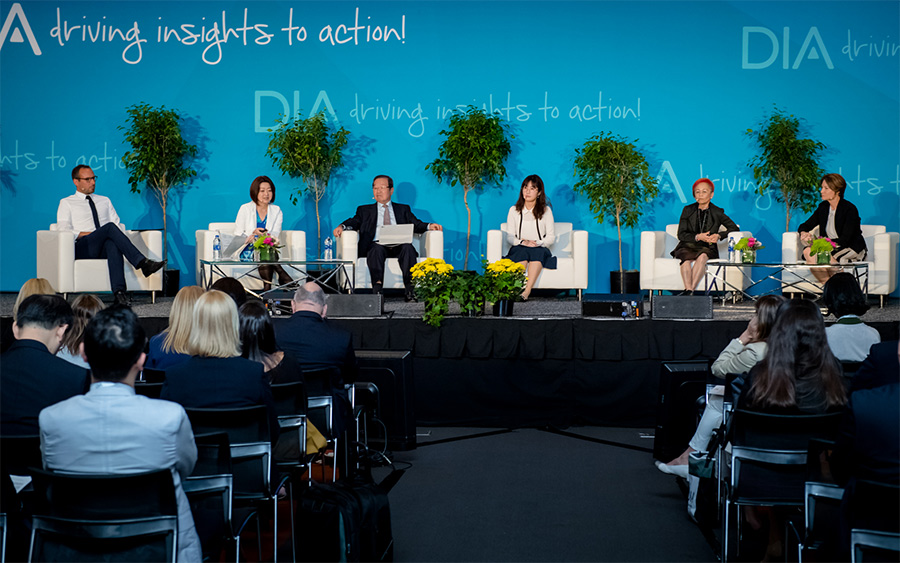Proceedings: DIA 2018 Global Annual Meeting

Patients as Partners:
Global Perspectives on Patient Engagement
Debra Michaels
DIA Senior Scientist
he meaning of true patient engagement quickly emerges as a requisite “level setting” before discussing where various regions of the world find themselves on the continuum of meaningful patient involvement in therapeutic product development. “Global Perspectives on Patient Engagement” convened a multi-stakeholder panel to discuss factors that have contributed to or hindered the advancement of patient engagement in regions outside the US and Europe.
Key Takeaways
- Early patient advocates in the US and Europe have helped establish a global understanding that true patient engagement goes beyond active involvement of patients as clinical trial participants.
- This understanding is shifting from the concept of “patients at the center” of drug development to the concept of “patients as partners throughout” development, approval, and access.
- Though much progress continues to be made, every stakeholder in every region can work to improve meaningful engagement of patients in drug development:
- Patients must become educated about the therapeutic development and approval processes in order to practice leadership in decision and policy making discussions.
- Physicians/healthcare providers must shift the patient-provider dynamic to encourage the patient’s active voice in their own care.
- Industry must develop and adopt systems, processes, and policies that support best patient engagement practices.
- Regulators must provide clarity about acceptable ways to engage patients, and which patient data are suitable for what purpose, in regulatory review and approval.
Global Forum Patient Engagement Co-Editor Deborah Collyar discusses the session’s key takeaways with panelist Jan Nissen.
Global Landscape
Due to the work of early patient advocates in the US and Europe, there is now an emerging global understanding that true patient engagement goes beyond the active involvement of patients in their role as patients (e.g., as participants in clinical trials). Sato described this as moving from the concept of putting the patient at the center to involving the patient as a partner in the development and approval of medicines, while Wong-Rieger encouraged more patient engagement in the policy arena, turning patients into leaders who shape policies for approvals of, and access to, new therapies. Respect for the patient as a partner throughout the medical products life cycle allows multi-directional dialogue to flourish – the key to advancing meaningful engagement among all stakeholders.
Asia
In contrast with most other regions, the impetus for advancing patient engagement in Asia has come more from the government and industry stakeholders than from patient communities. In Asian societies, such as in Japan and Korea, there is a deference to the government and healthcare institutions, including clinicians, and patients are less likely to speak out and to advocate for a greater role in the process.
In Japan, The Ministry of Health, Labour and Welfare conducts many of Japan’s patient engagement and education programs. MHLW educational programs include training patients to participate in research planning and evaluation, especially in oncology.
Patient engagement is relatively new in the Republic of Korea. Recent government policies support patient engagement and the Ministry of Food and Drugs Safety is expanding communication channels to collect input from patients on ways to improve their clinical trial experience. The pharmaceutical industry is also making strides in increasing patient awareness of the benefits of participating in clinical trials, but much work remains before patient engagement becomes an integral part of drug development.

Session Chair Mathieu Boudes with panelists Junko Sato, Young Jack Lee, Jieun Lee, Durhane Wong-Rieger, and Jan Nissen.
Session Chair: Mathieu Boudes, European Patients’ Forum
Panelists: Junko Sato, PMDA, Japan; Young Jack Lee, LSK Global PS (Republic of Korea); Jieun Lee, Ministry of Food & Drugs Safety, Republic of Korea; Durhane Wong-Rieger, Canadian Organization for Rare Disorders; Jan Nissen, Merck & Co., Inc.
Latin America
While there is much diversity among the healthcare systems of Latin American countries, patient advocates are, in general, pushing for clinicians, governments, and industry to be more open in their inclusion of patients in defining research and access programs. The International Alliance of Patients’ Organizations has been providing guidance to patient groups in this region. Furthermore, patient groups in Latin America have formed significant, strong patient community networks, and leverage social media and other communication methods to press for convergence of regulatory policies that best serve the needs of patients in their communities. They also look to emulate the experiences of patient groups in Europe who are becoming educated as patient experts through such programs as EUPATI in order to better contribute to discussions with industry and regulatory stakeholders.
Challenges for All
Some challenges of advancing true patient engagement are recognized by most regions, including Europe and the US. The image of the healthcare provider as the expert and best communicator of patient concerns is strong in Asia, for example, and is only beginning to change in Europe and the US. Disease-related stigmas that hamper the willingness of patients to speak out about their needs remain a persistent global problem.

